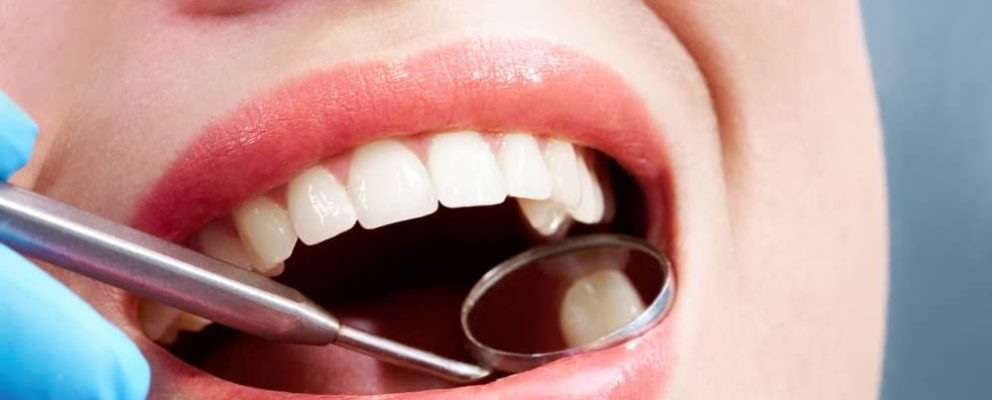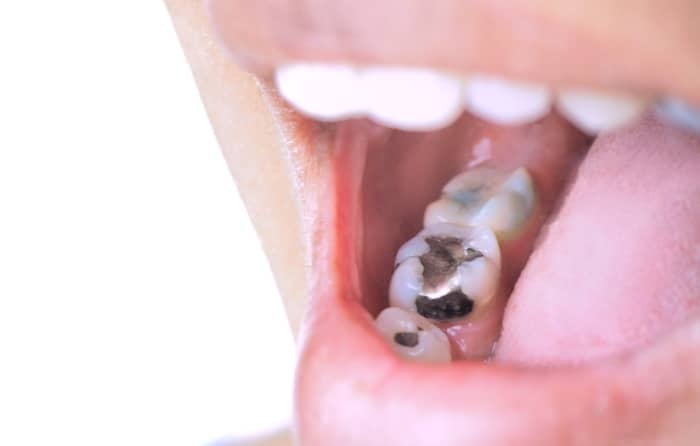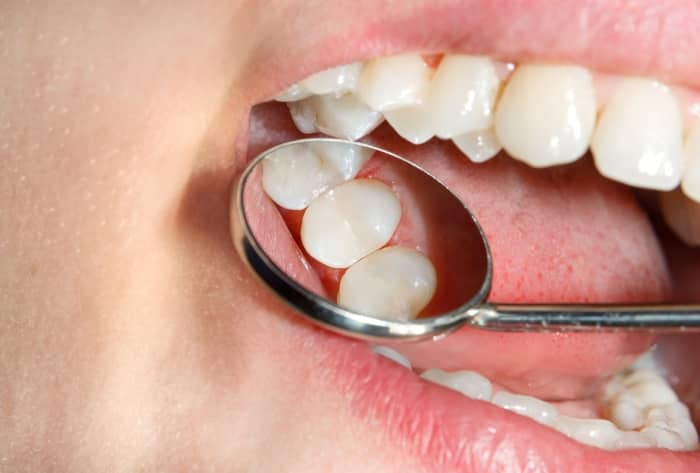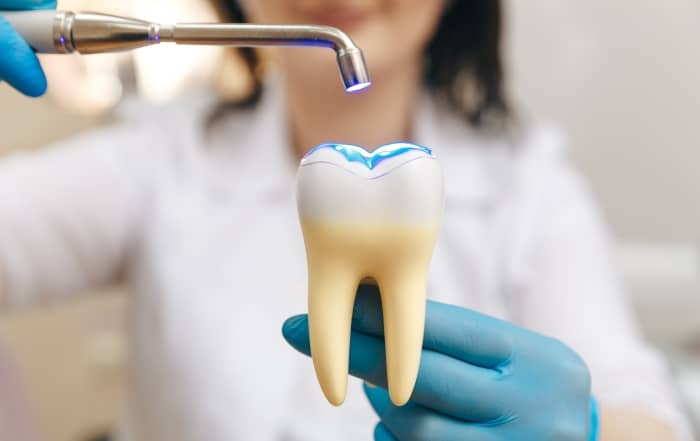Having cavities means that your teeth’s hard surfaces have become permanently damaged. Your teeth will have microscopic holes or openings that invite bacteria in shortly after. Cavities, caries, or tooth decay can be a result of several things, including bacteria build-up due to poor oral hygiene, frequent snacking, and eating too much sugar.
Thankfully, there are many ways to treat cavities, such as fluoride treatments, root canals, and crowns. But perhaps the most common is through tooth fillings.
In this article, you will learn about what a tooth filling is, the signs when you need one, and the many options and types of fillings available.
- What is a Tooth Filling?
- Signs That You Need a Tooth Filling
- Types of Tooth Fillings
- The Tooth Filling Process
- What to Expect After
What is a Tooth Filling?
Unfortunately, cavities do not go away on their own, which is why tooth filling may be necessary. Tooth flings are where composite, porcelain inlay/onlay, or similar material is inserted into the decayed tooth to fill the hole and restore its shape and function. Dental fillings are often the most commonly used method to prevent further tooth damage, especially due to cavities or decay.
The goal of tooth fillings is to close the holes off and remove the bacteria so that no further decay will occur.
Signs That You Need a Tooth Filling
If you have cavities, you’re not alone. The World Health Organisation (WHO) says that untreated cavities are a massive problem in over 2.3 million adults or those with permanent teeth. The best way to tell if you have decay is to go to the dentist. However, you can usually see and feel when you have cavities in your teeth. Here are some signs to watch out for:
- You can see a cavity. Dark holes are usually not so obvious to the naked eye. However, if you see a dark spot or a hole that’s big enough for you to spot, it’s certainly time to visit a dentist.
- You have tooth pain. Sometimes, people put off going to the dentist even when they have a toothache. They think that the pain will eventually go away, so they take over-the-counter meds for pain relief. It’s effective, but the pain will come back and will usually get worse. Next time you have any kind of tooth pain, don’t hesitate to schedule a dental appointment with Chelmsford Dental.
- You have sensitive teeth. Did your teeth suddenly become so sensitive, especially when you drink or eat anything hot or cold? Your cavities are likely the culprit as the holes make your teeth more sensitive.
- You have cracked or chipped teeth. Small tooth damage should not be taken lightly. Make sure that you book an appointment with your dentist to repair your tooth immediately.
One more reason people get fillings is if they have lost a filling. Fillings are not permanent and may fall out or become loose. You should see your dentist right away to prevent further weakening of the tooth.
Types of Tooth Fillings
There are now several filling materials available today, which are:
1. Gold
Gold tooth fillings can last for 10 to 15 years with the material’s incredible durability, but usually longer if cared for properly. The material does not corrode and is incredibly strong with the ability to withstand daily chewing and eating.
Of course, it’s more expensive than other materials and can be about 10 times the cost of amalgam fillings. You also need at least two office visits to complete the procedure. It’s also important to mention that gold can result in galvanic shock, which is very sharp pain when placed next to a silver amalgam. This is due to the interaction between the metals, with your saliva generating an electric shock-like experience. But don’t worry; it is usually rare. You also have to have silver and gold fillings next to each other.
One more consideration is aesthetics. Some people find gold or any coloured fillings less eye-pleasing than tooth-coloured ones.
2. Silver
A metal amalgam, silver fillings combine mercury, copper, silver, and tin. They are durable, especially compared to tooth-coloured fillings. Also, they are more affordable than gold and other materials.
One concern about silver fillings, though, is the mercury content. However, it has long been used, and experts have not found any evidence that they are harmful. Nevertheless, silver fillings are currently being phased out.
Another thing that makes silver unattractive is its dark colour. For this reason, it’s not used in visible areas like the front teeth. Before you get a silver amalgam filling, make sure that you understand that some parts of your tooth may be removed, including healthy and undamaged ones. This is done to accommodate the filling. That said, silver is durable and can last up to 15 years or more.
3. Porcelain/Ceramics
Porcelain inlay/onlay fillings mimic the colour of the teeth, making them an attractive option for younger people and adults, as well. They are durable, too, sometimes lasting up to 15 or even 20 years. Although expensive, these fillings can resist staining better than composite resin materials. Porcelain can cost almost similar to gold fillings.
4. Tooth Coloured Composite Fillings
Perhaps the number one reason composites are popular is due to their appearance. They can have the same colour or shade of the teeth, allowing them to be placed in front of the more visible areas of the mouth. One great benefit of using composites is that they chemically bond to the structure of the teeth, which gives more strength and support to the teeth. Composite fillings are also durable and can be used to repair broken or chipped teeth. There’s also less space required for a composite, so less tooth structure will be removed.
However, although composites are durable, they can wear out quickly, usually up to 10 years. When used for large cavities, they may not last long because they cannot withstand chewing pressure. Additionally, composites take longer to apply and may require additional visits.
5. Glass Ionomer
This filling material is made of acrylic and glass. Glass ionomers are often for fillings below the gum line. They are also prescribed to younger children but remember that drilling may still be necessary. The beauty of glass ionomers is that they release fluoride, which protects the teeth from developing more cavities. However, you should remember that this material is weaker than composites.
The Tooth Filling Process
A filling is generally a painless procedure and will often take about 20 minutes to an hour to complete, sometimes longer if you require multiple fillings or have a unique tooth structure. Nevertheless, here are the steps that usually take place in a typical tooth filling procedure:
- The dentist will first numb the area around the tooth using a local anaesthetic.
- The dentist will then use a drill, laser, or air abrasion instrument to remove the decay.
- Dentists usually take a little bit of time to test or probe the spot where the cavity was as part of preparing the area for filling is to ensure that the decay is completely removed.
- Once the decay is confirmed to have been removed entirely, the dentist will prepare the area by cleaning and eliminating debris and bacteria.
- The filling will be applied to the space where the decay once was.
After the filling is in, finishing touches and polishing will follow.
There are also extra steps if you will have tooth-coloured fillings:
- After the decay has been removed and the dentist has cleaned that particular spot, the filling material will be applied to the tooth in layers.
- Curing is next, where a special light is used to harden every time a layer is applied.
- After completing the multilayering process, shaping the composite material follows to achieve a realistic result.
- Any excess material will be trimmed off.
- Final restoration will include polishing.
In cases where the decay is close to the root of the teeth, an additional step is done after cleaning the space. Your dentist may first insert a liner, which is typically made of composite resin or glass ionomer (or other material). Doing so will help protect the nerve.
A simple filling can take as quickly as 20 minutes. The advantage of technology today allows dental offices to make inlays and onlays in just one appointment. In the end, it still depends on the materials used. Here’s an overview:
- Composite resin material takes longer, particularly because it is applied layer by layer. However, the procedure only requires one visit.
- For composite fillings that will be made from an impression, a second visit may be necessary for bonding the filling.
- If the dental office has the required equipment, you can have inlays/onlays (gold or porcelain fillings) in one sitting. However, it can take about two visits in many cases, with the first one involving decay removal and cleaning and making tooth impressions. The second visit is for bonding the filling.
If you have your older filling replaced, the process is usually the same and will take the same amount of time, unless the old filling has to be removed by drilling it out.
What to Expect After
Your experience may differ depending on the material used. For example, if you have an amalgam filling, it can take about an hour to set. However, it requires 24 hours to completely set. You should not eat hard foods during that time. Meanwhile, if you have composite or glass ionomer, they will be cured by light, so they readily set in two to 20 seconds for everyone to a two-millimetre thick layer.
You do not have to worry about ceramic fillings because they set immediately. Dentists use blue wavelength light to cure the material, which has already been fired or milled. All it needs is an adhesive to make sure it stays in place.
After the procedure, your filling should heal without any complications. The anaesthetic will eventually wear off, so expect a feeling of sensitivity around the tooth that has been filled. But don’t worry; this sensitivity generally goes away after a day or so. For metal fillings, including gold and silver, you may want to avoid anything cold for the next several days to weeks. Although the increased sensitivity is rare for glass ionomer or composite fillings, it can still happen, so be a little cautious.
A good way to stop tooth sensitivity or at least reduce it is to avoid chewing with the side of the mouth that has been treated. You should not skip brushing or flossing, but be careful in doing so. It also makes sense to avoid hot and cold drinks and foods, as well as acidic ones. If sensitivity is more than usual, you may want to switch to a toothpaste for sensitive teeth. It would also be helpful to take non-steroidal anti-inflammatory drugs, such as ibuprofen, which you can get over the counter.
If the sensitivity has not subsided after a week or you feel pain that lasts long, you should immediately let your dentist know about your concerns. Also, call your dentist if your bite feels off.
We have given estimates for how long the fillings normally last, but their lifespan will still depend on your dental hygiene. By brushing and flossing diligently, you can extend the life of your dental filling. Additionally, you have less to worry about when it comes to forming new cavities.
Do you think you need a filling? Get your regular check-up scheduled today. Visit our appointment page for more information.








